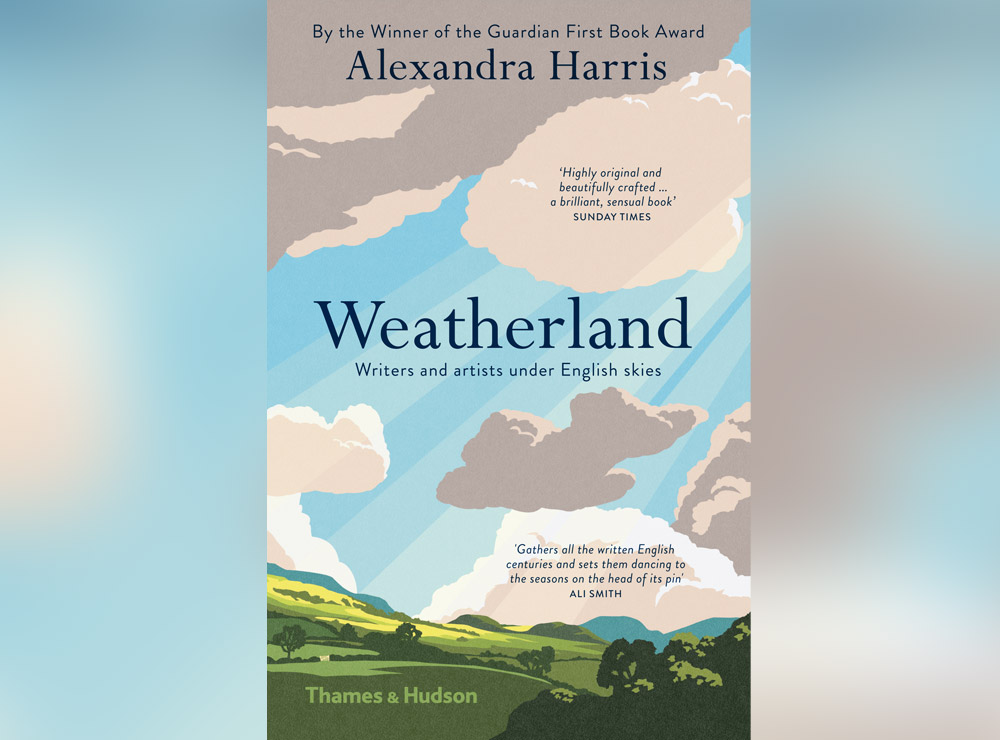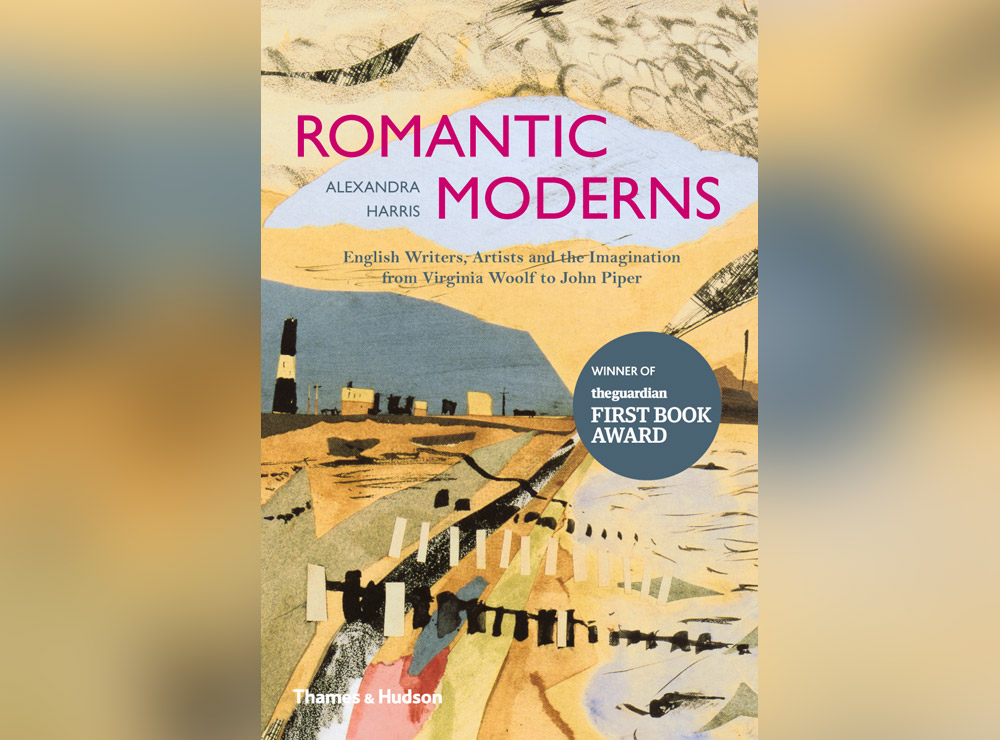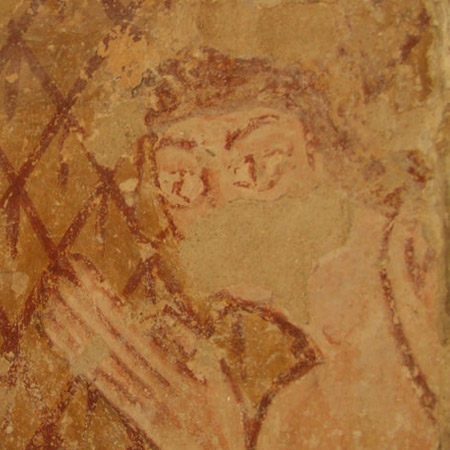Extract: Weatherland
From the introduction to Weatherland
A Mirror in the Sky
I hope you are better employed than in gaping after weather.
– John Keats[i]
It’s December, the week before Christmas. I have rented for a few nights a sixteenth-century tower in the water meadows under the South Downs in East Sussex. The closest village is Laughton, which is not very near Lewes, though the lights on the edge of town become visible in the distance after dark, and every half hour a train goes along beneath the horizon. Leaning out of a high bedroom window, I have a better view of the ditches and sluices carrying water quietly away across the fields in the moonlight.
In the night I wake up damp with cold. Any movement, even to scratch my nose, creates a breeze. A hot-water bottle lies uselessly beside me, its heat long gone and the kettle which would rejuvenate it sixty-two steps down a spiral staircase in the kitchen. For two hours I lie awake thinking about our sensitivity to temperature, wondering whether people felt cold in this room four hundred years ago, one hundred years ago, twenty years ago. The new thermostat at home works doggedly to keep me at the same temperature all day long; however much I turn it down it flicks on again and wins eventually, insisting on temperate regularity. I am losing the capacity to be comfortably cold. I resist the hot-water bottle, try to enjoy the passing draughts, and fall asleep.
The morning is so triumphantly bright that when I wipe condensation from the window I can see the texture of the grass on Mount Caburn. It is the kind of sharp low light in which archaeologists can see field boundaries and lost villages, a light for seeking out long-buried things. Falling on a notebook by the window, it makes a furrowed landscape of a previously flat page. I proceed to spend most of the day rejoicing in the weather. At Alciston white light comes shafting through the plain church windows as if the pale sun itself had turned protestant; at Alfriston in the afternoon the reed beds turn a tawny orange-grey, gently luminous beyond hedges of dark ilex and yew.
Weather is so mobile that it brings variance to tarmacked roads and concrete towers; a bare wall watched over time is interesting enough. In places where every surface is a different texture, where there are foregrounds and distances, shining berries, dense hollies, building stones which absorb the light in distinctive ways, there is almost too much to look at. I keep taking photographs, trying to catch each shading difference in colour as the afternoon goes on. You’d think I had never seen winter sun before.
Everything changes in the night: as I climb the sixty-two stairs the wind gets louder, and on each of the four floors, going up, I can hear the rain being thrown against the windows with more force. By dawn the meadows are flooded, leaving only small peninsulas of land. The sluice gate by the drive has been overwhelmed by what is now a fast-flowing river. There is no way of getting the car out but, since there seems to be a bit of footpath left, I cannot keep back the impulse to explore on foot. The aim is to collect a Christmas goose ordered from a farm about a mile away. Squelching and sinking, I make it across two fields before coming to a fast river I won’t risk. It is still raining, and the water is going up. If I reached the goose, I’d never get it back. We’ll have a vegetarian dinner.
I love this deluge. Flooding in towns can wreck homes and livelihoods, but here on the marshes flooding is supposed to happen in winter. These low fields have for centuries being taking the burden of the water. The flood laps up to the hawthorn hedges where a few hips show red against the grey. Clumps of brown rotting thistles keep their heads above water. While I’ve been gazing, local people have had the forethought to mark the edge of the submerged road with stakes so that it’s possible to wade through without losing the way. They have also devised a plan for getting in the shopping. A car from the outside world is parked on the far side of the water with a boot full of festive food. Two bags at a time, our neighbour carries his supplies across the flood to his own car, a dock for the ferry’s cargo.
In the evening, when the rain stops and the air is still, I go out again. There are small waves breaking gently on the inland sea. The stakes along the road are only beanpoles, but the wobbly verticals look dramatic. There is enough moonlight to see the outline of Caburn, which is now a cliff rising above water. Gulls have come in from the coast, claiming the levels as their own. Indoors, I find a set of postcards in a drawer, showing Laughton under blue summer skies. There are deckchairs stowed in a cupboard on the stairs. It’s a shock to see them: immersed in December I find it hard to believe in August. This is one of many strange characteristics of our relationship with weather: it is difficult to remember what it feels like to be in any conditions except the ones we’re in. It is almost impossible to pack the right things for a different climate. I can’t even imagine these floods going down.
But they do go down, very quickly. I drive away next day at low tide when the water reveals the land again. The sluice flows along innocently between its banks. The gulls have gathered on the last lake left to them, which sparkles in the sun. So that was my holiday. I have done nothing but watch the light and the water, and feel the cold, the wet, the wind, and afterwards the warmth. There are places where these things are so all-consuming that there’s time for little else.
*
Weather is written into our landscape. I grew up near Coldwaltham in West Sussex, where at some point in the Middle Ages the identity of coldness was attached to the Old English ‘waltham’ (village in the wood). A few miles away, moist air collects in the lea of the downs around Coldharbour Farm (a harbour or shelter from the cold). Chalk Farm in London has its etymological roots in ‘chalde’ from Old English ‘ceald’. Across England there are winterbournes, streams which rise when the water-table is high in winter and recede unobtrusively into the drier landscape of summer.[i]
Weather leaves its physical trace, but there are many aspects of weather which are insubstantial. As the anthropologist Tim Ingold observes, we can feel warmth but we cannot touch it. We can see where a cloud is and where it is not, but we cannot run a finger around its edges.[ii] Shakespeare thought of clouds ‘dislimning’. To ‘limn’ is to delineate, but weather is inimical to lines, dissolving them as soon as they are made. Meteorological phenomena are serially elusive. Winds and air-fronts reveal their characters only in the effects they have on other things. We learn the nature of wind by observing how far smoke drifts from the vertical, or by watching to see whether twigs are moving or just the leaves: the Beaufort Scale uses these signs from the visible world as a gauge for the invisible wind. We all have our personal variants on the official scale, the things we look to for clues, and we come to understand places through the marks the wind has made on them. Emily Brontë described the wind at Wuthering Heights by reading the angle of its trees: ‘one may guess the power of the north wind blowing over the edge, by the excessive slant of a few stunted firs at the end of the house; and by a range of gaunt thorns all stretching their limbs one way, as if craving alms of the sun’. These are the expressive signs of wind, though they are not the wind itself.[iii]
This elusiveness, combined with tremendous power, means that in almost every culture the weather has at some stage been thought divine. It has in turn provided the imagery by which deities are known. The Christian God, everywhere present but nowhere visible except in His workings, is often represented as a figure emerging from cloud or air. Speaking out of a whirlwind to put Job in his place, God defines omnipotence through His command of weather. His speech, as translated in the King James Bible of 1611, poses some of the most beautiful and enduring questions in literature:
Hast thou entered into the treasures of the snow? or hast thou seen the treasures of the hail, which I have reserved against the time of trouble, against the day of battle and war? By what way is the light parted, which scattereth the east wind upon the earth? Who hath divided a watercourse for the overflowing of waters, or a way for the lightning of thunder; To cause it to rain on the earth, where no man is; on the wilderness, wherein there is no man; To satisfy the desolate and waste ground; and to cause the bud of the tender herb to spring forth? Hath the rain a father? or who hath begotten the drops of dew?[iv]
The secret workings of weather are here imagined in ways which are at once solid and elusive. Snow and hail exist in permanent states, stored up for the future. A ‘way’ must be made for the lightning because the Israelites believed the sky to be a solid layer between the earth and the heavens, through which channels were cut for the weather. The sky was often described as a sheet of metal, polished to reflect the light. The King James translators, working in a new age of mirrors, likened the sky to ‘a molten looking glass’.[v] These images of the sky as a solid architectural structure are combined with lyric appreciation of the delicacy and diversity of weather. God’s words to Job, though spoken in anger, describe the extent of His power in relation to dewdrops as well as lightning. The questions are presented rhetorically because it should be obvious to Job that the answer in every case is God. But the point is also that these are great mysteries of the world, and so they have remained. Today, whether or not we find God in snow, we continue to feel wonder.
The Christian story proposes variable weather as one of the penalties brought down on humankind for its sins. In Eden there was moisture to nurture the abundant plants, and such warmth that Adam and Eve needed no extra layers. If there was ‘weather’ at all, it was steadily benign. The trouble began either immediately after the Fall or with the Flood. John Milton in Paradise Lost described the creation of weather as one of the dire ‘alterations in the heavens and elements’ set in train by God as soon as the apple was eaten.[vi] Winds were summoned to do battle in the air. Angels tipped the earth on its axis, subjecting it to the variability of seasons. Man would now have to cope with the unpredictability of a lopsided globe. The twinned genesis of weather and time is remembered in the French phrase ‘les temps’, Spanish ‘tiempo’ and Italian ‘tempo’. Having lost the eternal stability of Eden, man must live in passing airs and hours.[vii]
The worst of the Old Testament punishments came in the form of calamitous weather. The Flood demonstrated to Noah and to centuries of Bible-readers that rainfall is capable of wiping out human life. Later floods, gales, and freezes have been understood by many who suffered in them as sequels to those first, awful retributions. During the Middle Ages and the Renaissance it was commonly believed that the earth was yearly getting colder as it left temperate Eden further and further behind. This was easily conflated with the classical scheme in which Jupiter introduced the seasons after the perpetual spring of the golden age. We still ask ourselves on a daily basis if the weather is a curse or a blessing. We still see both horror and treasure in hail.
Notes
Introduction: A Mirror in the Sky
[i] Keats to J. H. Reynolds, 21 September 1819, Selected Letters, 264.
[ii] Judith Glover, The Place Names of Sussex (Batsford, 1975, 1986), 37; John Field, Place-Names of Greater London (Batsford, 1980), 12; Richard Hamblyn, ‘Winter’, in The River Winter, ed. Jem Southam (Mack Books, 2012), n.p.
[iii] Ingold, ‘Earth, Sky, Wind, and Weather’, in Being Alive, 115–125.
[iv] Antony and Cleopatra 4: 14; on Beaufort Scale see Huler, Defining the Wind; Brontë,Wuthering Heights, vol. 1, ch. 1, p. 2.
[v] King James version, Job 38: 22–28.
[vi] King James version, Job 37:18. Coverdale gives the sky as ‘clear metal’.
[vii] Milton, Paradise Lost, 10: ‘the argument’ and ll. 650–707. The Bible leaves much room for doubt about when, where, and how weather began. Genesis 2: 5–6, prior to the creation of man, ‘the Lord God had not caused it to rain upon the earth, and there was not a man to till the ground. But there went up a mist from the face of the earth, and watered the whole face of the ground’. The next definite mention of weather is at the Flood.
[viii] Michel Serres, The Natural Contract (1990), trans. Elizabeth MacArthur and William Paulson (University of Michigan Press, 2005), 27: ‘By chance or wisdom, the French language uses a single word, temps, for the time that passes and the weather outside’. The etymology suggests a history more interesting than chance: Latin ‘tempestas’ meant variously and interrelatedly ‘period of time’, ‘season’, ‘period of weather’.









